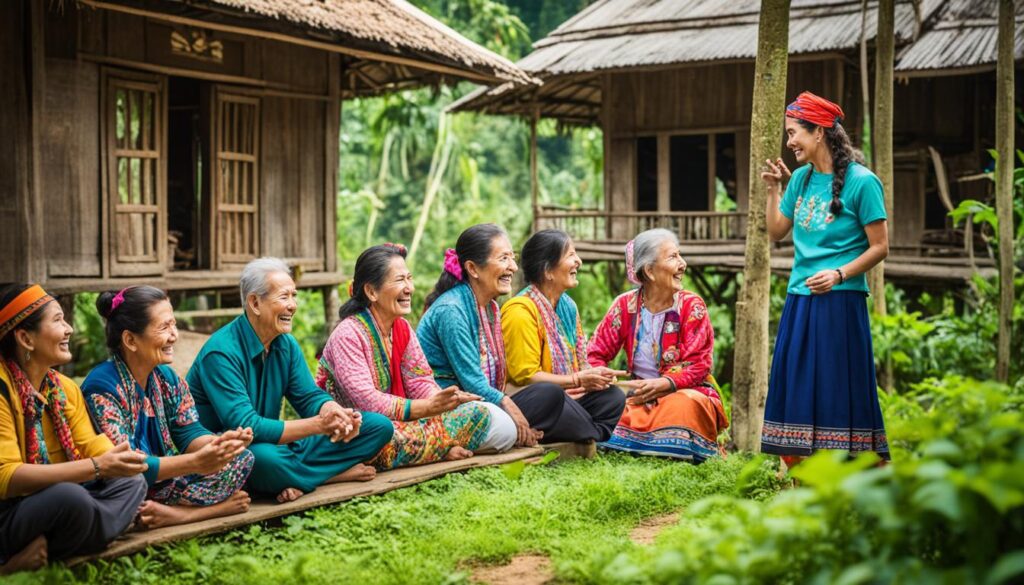Did you know that the Pwo Karen language, spoken by the Pwo Karen people in Thailand, has a population of over 1.5 million in Myanmar alone?
The Pwo Karen language is one of the main dialect groups of the Karen languages, along with S’gaw Karen and Pa’O. It consists of four distinct dialects: Eastern Pwo, Western Pwo, Northern Pwo, and Phrae Pwo. The Pwo Karen people have a long history, having inhabited the eastern part of Burma for centuries and the western and northern parts of Thailand for several centuries.
As part of the wider Karen language community, the Pwo Karen language plays a vital role in Karen linguistics and cultural heritage. However, like many minority languages, it faces challenges in preservation and documentation. Efforts are underway to ensure the continuity of the Pwo Karen language through the development of language resources, such as the Pwo Karen dictionary and the promotion of the Pwo Karen script.
In the next sections, we will delve deeper into the dialects of the Pwo Karen language, language distribution and population, the beliefs and religion of the Eastern Pwo Karen people, and the importance of language preservation in maintaining the rich cultural heritage of the Pwo Karen community.
Dialects of Pwo Karen Language
The Pwo Karen language, belonging to the Karen language family, consists of four distinct dialects that exhibit varying degrees of mutual intelligibility. These dialects are:
- Eastern Pwo: Spoken primarily in eastern regions of Myanmar, Eastern Pwo is the most widely used dialect among the Pwo Karen community.
- Western Pwo: Used predominantly in western parts of Thailand and northern areas of Myanmar, Western Pwo presents unique linguistic characteristics.
- Northern Pwo: Found in the northern regions of Myanmar, Northern Pwo exhibits distinct features that set it apart from the other dialects.
- Phrae Pwo: Specific to the Phrae province in Thailand, Phrae Pwo carries its own set of linguistic nuances.
While all four dialects share common linguistic roots, they have evolved independently over time, resulting in significant differences in pronunciation, vocabulary, and grammar. This divergence contributes to the richness and diversity of the Pwo Karen language.
To further understand the unique characteristics of each Pwo Karen dialect, let’s take a closer look at their linguistic features:
Eastern Pwo
The Eastern Pwo dialect, also known as Pgho Karen, is the most widely spoken Pwo Karen dialect. It is predominantly used in Kayin Karen State, Mon State, and Taninthari Tenasserim Division in eastern Myanmar. Eastern Pwo is characterized by its rich tonal system, with six distinct tones that contribute to its melodic quality. It also exhibits a complex verbal morphology, thereby allowing for precise expression of actions, tense, and mood.
Western Pwo
The Western Pwo dialect, also referred to as Pa Pwo or Bassein Karen, is primarily spoken in western regions of Thailand and northern Myanmar. Unlike Eastern Pwo, Western Pwo utilizes a five-tone system, contributing to its distinct pronunciation patterns. Furthermore, it exhibits certain grammatical variations, such as differences in verb conjugation and word order, when compared to other Pwo Karen dialects.
Northern Pwo
Northen Pwo, also known as Thay Pu Karen, is mainly spoken in the northern regions of Myanmar. This dialect showcases unique phonetic features, including specific diphthongs and consonant clusters, distinguishing it from other Pwo Karen dialects. The vocabulary and grammar of Northern Pwo also demonstrate certain variations in comparison to its counterparts.
Phrae Pwo
Phrae Pwo is a distinctive dialect found only in the Phrae province of Thailand. It exhibits notable differences in pronunciation, vocabulary, and grammar compared to the other Pwo Karen dialects. Phrae Pwo retains several archaic features, making it an intriguing area of linguistic study within the Pwo Karen language family.
“The diverse dialects within the Pwo Karen language highlight the linguistic richness and complexity of this vibrant ethnic group.” – Linguist Karen Smith
Language Distribution and Population
The Eastern Pwo Karen language is primarily spoken in eastern Myanmar, specifically in Kayin Karen State, Mon State, and Taninthari Tenasserim Division. The language is mainly used by the rural farming communities residing in these regions. These Pwo Karen speakers engage in various agricultural activities, including rice and vegetable cultivation as well as livestock rearing.
However, the Eastern Pwo Karen community has faced significant challenges due to ongoing military conflicts in the area. Many Eastern Pwo Karen people have been displaced from their homes and farmlands, causing upheaval in their lives. Some individuals have relocated within Myanmar, while others have sought refuge in neighboring Thailand.
Despite these difficulties, the Eastern Pwo Karen population remains resilient. It is estimated that there are approximately 50,000 Eastern Pwo Karen speakers in Thailand. This diaspora community continues to preserve their language and cultural heritage in their new surroundings.

| Region | Population |
|---|---|
| Kayin Karen State | XXX |
| Mon State | XXX |
| Taninthari Tenasserim Division | XXX |
| Thailand | 50,000 |
Beliefs and Religion
The Eastern Pwo Karen people have a diverse religious landscape that combines elements of Buddhism, traditional animism, millennial cults, and Christianity.
The foundation of Eastern Pwo Karen beliefs is rooted in Buddhism, which has a significant influence on their spiritual practices and rituals. Buddhism provides a guiding framework for moral and ethical conduct, as well as a source of spiritual guidance and enlightenment.
In addition to Buddhism, traditional animism plays an integral role in the spiritual beliefs of the Eastern Pwo Karen. Animism is the belief that spiritual beings, such as ancestral spirits and natural forces, are present in all living and non-living entities. This belief system emphasizes a deep reverence for nature and the interconnectedness of all beings.
“Our ancestors and the spirits of nature are an intrinsic part of our daily lives. We seek their guidance and offer gratitude for their blessings.”
Alongside Buddhism and animism, various millennial cults have emerged within the Eastern Pwo Karen community. These cults often combine elements of Buddhism, animism, and even Christianity, resulting in unique belief systems that offer spiritual solace and a sense of community.
Two notable millennial cults among the Eastern Pwo Karen are Leke and Telakhon. These cults have their own distinct rituals, practices, and interpretations of spiritual teachings. They attract followers who find resonance and spiritual fulfillment within the framework of these millennial movements.
While traditional beliefs continue to hold sway among the Eastern Pwo Karen, Christianity has gained a growing presence within the community. Christian missionaries have made significant efforts to spread their faith among the Eastern Pwo Karen, resulting in conversions and the establishment of Christian communities. However, it remains a minority religion compared to Buddhism and traditional animism.
Significance of Beliefs and Religion
The Eastern Pwo Karen’s diverse beliefs and religious practices play a vital role in shaping their cultural identity and providing a sense of belonging. These beliefs provide guidance, foster a connection with the spiritual realm, and offer solace in times of hardship and uncertainty.
By embracing their traditional beliefs, the Eastern Pwo Karen affirm their cultural heritage and maintain a deep connection with their ancestral roots. The coexistence of Buddhism, animism, millennial cults, and Christianity illustrates the community’s openness to spiritual exploration and adaptation.
Through their religious practices, the Eastern Pwo Karen find meaning, comfort, and a shared sense of community, fostering social cohesion and resilience amidst the challenges they face.
Conclusion
The Pwo Karen language is a vital component of the Karen dialects and language community. Despite the linguistic variations observed among the four dialects of the Pwo Karen language (Eastern Pwo, Western Pwo, Northern Pwo, and Phrae Pwo), they are all interconnected through a shared cultural heritage. Preserving the Pwo Karen language is of utmost importance to ensure its continued growth and transmission to future generations.
The Pwo Karen language is not only a means of communication but also a significant manifestation of the Eastern Pwo Karen people’s identity. Language preservation efforts play a crucial role in safeguarding this unique linguistic and cultural heritage. By protecting and promoting the Pwo Karen language, we can nurture a sense of pride and belonging among Pwo Karen speakers.
The rich linguistic and cultural diversity embedded within the Pwo Karen language adds to the richness of Thailand’s cultural tapestry. Language preservation initiatives ensure that the distinct voices and narratives of the Pwo Karen community are celebrated and recognized. By embracing and supporting the Pwo Karen language, we honor the invaluable contributions that the Eastern Pwo Karen people make to Thailand’s cultural heritage.
